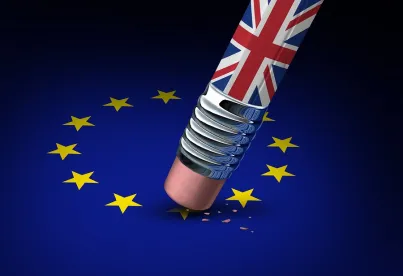I. What is Brexit?
Brexit (short for “British exit”) is the United Kingdom’s (the “UK”—England, Scotland, Wales and Northern Ireland) decision to leave the European Union (the “EU”—28 countries, including the UK). The UK joined the EU, then known as the EEC (European Economic Community), in 1973.
On June 23, 2016, the UK public voted (in a referendum) to leave the EU, 52% to 48%. Since the vote, exit negotiations have been taking place between the UK and the other EU countries.
The exit is currently scheduled to happen on March 29, 2019 at 11:00 p.m. The current proposal (more on this below) is that there will then be a 21-month “transition period” until December 31, 2020 (with one optional extension), in which the post-Brexit rules will be hammered out and businesses and others can prepare for the new rules.
II. Where are we Now?
The UK and the EU have been negotiating a withdrawal agreement, which would define the parameters of the UK’s “divorce” from the EU and which includes a 21 month transition period. However, negotiations have been sticky and there is not currently an agreement. A draft withdrawal agreement was approved and signed by the EU commission and awaits UK Parliamentary approval. However, on January 29, 2019, the UK Parliament refused to approve the version of the withdrawal agreement signed by the EU until certain aspects were renegotiated.
At this point, there are three possible outcomes: (1) the EU and the UK will agree to a withdrawal agreement prior to March 29, 2019, and the UK will leave the EU pursuant to the withdrawal agreement (a so-called “deal” scenario); (2) the EU and the UK will not reach an agreement in time, and the UK will leave the EU without a deal (a so-called “no-deal” scenario); or (3) the UK Parliament will vote to delay its departure from the EU or any number of other options which also include a second referendum.
Under the first scenario, the exit will move forward under the parameters set forth in the withdrawal agreement. In the current draft of the withdrawal agreement, 15 of the 585 pages are dedicated to intellectual property (“IP”). However, the rules that will follow the transition period are not finalized. There is a separate 26-page “Political Declaration” that outlines the EU and the UK’s goals with respect to IP, but this is not binding. The rules for after the transition period would need to be worked out during the transition period.
There is a great deal of uncertainty in the event of the second, “no deal” scenario. While the UK government has issued a number of notices declaring their intent should a “no deal” scenario occur, these are not binding. Generally, for IP rights, the UK plans to move forward under the terms in the withdrawal agreement to the best of its ability, whether or not there is a deal.
Finally, should the UK elect to postpone or revoke Brexit and remain in the EU, the UK would remain subject to the current EU IP regime for however long the UK remained a part of the EU.
It is important to note that the IP issues covered below are not exhaustive, and are subject to change throughout the exit and transition periods.
III. What is the Impact of Brexit on IP rights?
To minimize the disruption caused by the exit on IP right holders, the UK government has stated that their goal for IP rights in the UK post-Brexit is to recognize existing EU rights in the UK by creating duplicate protections in UK law and provide continuity where possible.
While exit term negotiations continue, EU IP laws continue to apply in the UK. There are certain types of IP rights that will not change even with Brexit, including:
1. UK IP Rights: UK registered and unregistered patents, trademarks, designs and copyrights will remain intact.
2. European Patents: With Brexit, there will be no impact on the current European patent system. Issued European patents obtained from the European Patent Office will remain in effect as they are not tied to EU membership. The Brexit vote does not mean the UK ceases to be a member state of the European Patent Convention that established the European patent system. Pending and future European patent system applications will also not be impacted by Brexit.
a. In addition to remaining in the European Patent system, the UK government plans to continue participating in the unitary patent system and the Unified Patent Court that underpins it.
Patent
While Brexit will have no impact on the European Patent system, there are a number of biotechnological and pharmaceutical patent provisions in EU law. Post-Brexit, the relevant EU legislation (or its domestic implementation) will presumably be retained in UK law under the European Union (Withdrawal) Act 2018.
For example, the EU Supplementary Protection Certificate (“SPC”) provides for an additional period of protection after a patent has run out for patented pharmaceutical products and agrochemicals. Post-Brexit, the UK government has stated the current SPC legal framework in the UK will be maintained.
Trademark and Design
The UK government has stated that, deal or no-deal, all granted EU trademarks and designs will be duplicated in the UK with the same level of protection. Any applicants with pending EU trademark or Community design applications at the time of the exit will be able to refile, within nine months of the exit, and retain the EU application date for priority purposes. The UK government is working with organizations like the World Intellectual Property Organization to provide continued protections in the UK for trademarks and registered designs through the Madrid and Hague systems.
Currently, the UK unregistered design right and EU unregistered Community designs provide protections with different durations and scope. Post-Brexit, the UK plans to continue to protect and enforce all existing EU unregistered Community designs for the remaining period of protection of the right. The UK has stated that this process will be free and automatic.
To protect designs disclosed in the UK post-Brexit, the UK plans to create a new unregistered design right in UK law which mirrors the characteristics of the EU unregistered Community design.
Copyright
The majority of rights (such as music, films, books and photographs) are protected around the world. The UK is a member of a number of international treaties and agreements protecting copyright. This will continue to be the case following Brexit.
Currently, the UK government has implemented certain EU cross-border copyright mechanisms in UK legislation (e.g., sui generis database rights, the orphan works (works without documented owners) copyright exception, the country-of-origin principle for copyright clearance in satellite broadcasting, etc.); however, in the event of a no-deal scenario, the UK will lose the reciprocal element of these mechanisms and many will no longer work in the way they are intended.
Exhaustion of IP Rights
The exhaustion of IP rights is the loss of the right to control distribution and resale of that product after it has been placed on the market within a specified territory by, or with the permission of, the right holder.
The UK is currently part of a regional European Economic Area (“EEA”) exhaustion scheme, meaning that IP rights are considered exhausted once they have been put on the market anywhere in the EEA with the right holder’s permission. Post-Brexit, the UK likely will continue to apply the EEA exhaustion scheme, though this hinges on future negotiations between the UK and the EU.
IV. What Can I do in Preparation for Brexit?
-
Preform an IP portfolio review
-
Identify EU trademark and design rights and consider registering any vital rights in the UK
-
Assess the impact of the post-Brexit changes on licensing agreements, injunctions, marketing strategies, etc.
-
Plan ahead for UK and EU applications to be filed post-Brexit (e.g., EU trademarks cannot show distinctiveness through use only in the UK)





 />i
/>i
